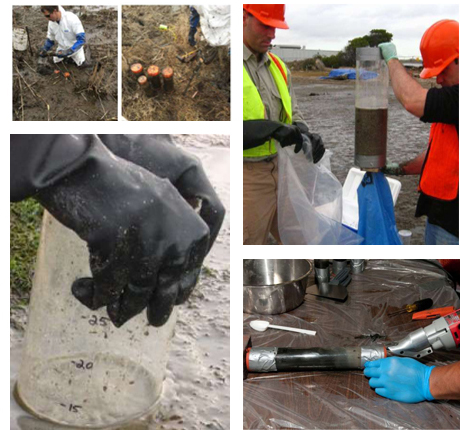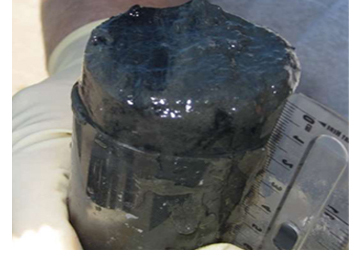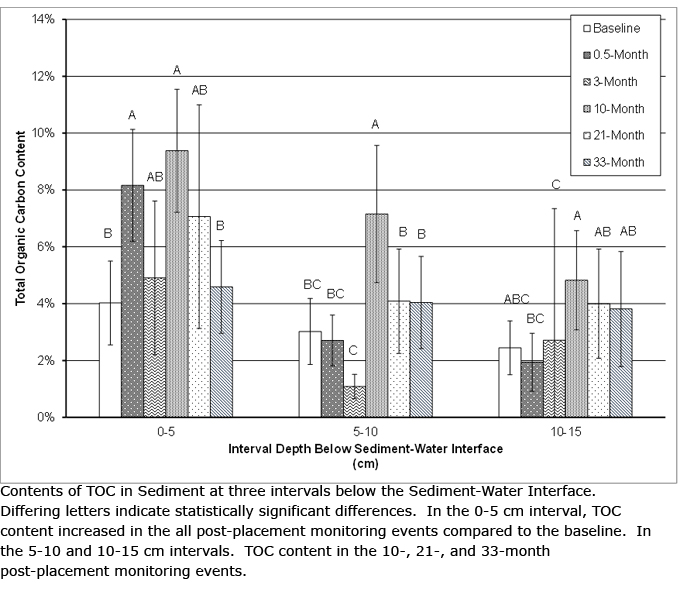SEDIMENT CORE PROFILING
Collecting and analyzing sediment core profiles are the single-most important tool for evaluating
amendment placement efficiency, and long-term efficacy of the amendment for HOC sequestration.
Sediment cores collected from a treatment area can be used for
- Visual confirmation of the depth and aerial coverage of AC placement
- Analytical measures of total and black carbon pre-placement, post-placement and LTM
- Total bulk sediment hydrophobic organic compounds
- Ex situ porewater measures (passive samplers)
- Ex situ bioaccumulation testing
- Measures for changes to benthic infaunal populations
- Vertical measures in narrow increments (generally 2 cm) provide a means to assess mixing
The table below provides examples of the use of sediment core profiles at AC demonstration sites
|
Site |
Contaminant |
Year Con-structed |
Core Profile |
Project Web Link |
|
AC Vertical and Horizontal Distribution |
Total and
Black Carbon |
Bulk
Sediment HOCs |
Ex Situ
Porewater |
Ex Situ
Bio-accumulation |
Benthic
Infauna |
Activated Carbon Pilot Study,
Lower Duwamish Waterway, Seattle, WA |
PCBs |
2017 |
✔ |
✔ |
✔ |
|
✔ |
✔ |
LDWG Web Site |
USN Sierra 1B Pier
Pearl Harbor, HI |
PCBs &
mercury |
2015 |
✔ |
✔ |
✔ |
|
✔ |
|
USN Sierra 1 B Case Study |
Mirror Lake Restoration
Dover DE |
PCBs |
2014 |
✔ |
✔ |
✔ |
|
|
|
Mirror
Lake Case Study |
Puget Sound Naval Shipyard
Bremerton, WA |
PCBs & mercury |
2012 |
✔ |
✔ |
✔ |
✔ |
✔ |
✔ |
PSNS Case Study |
|
Berry’s Creek, NJ |
Mercury & PCBs |
2012 |
✔ |
✔ |
✔ |
|
✔ |
|
EPA, 2013 |
|
ESTCP ER-200835 |
Lower Duwamish Slip 4
Seattle, WA |
PCBs |
2011 |
✔ |
✔ |
✔ |
|
|
|
Slip 4
Lower Duwamish Case Study |
|
Canal Creek, MD |
PCBs & mercury |
2010 |
✔ |
✔ |
✔ |
✔ |
✔ |
✔ |
Canal Creek Case
Study |
|
ESTCP ER-200835 |
|
Naval Air Station, Cottonwood Bay, Dallas TX |
PCBs, PAHs, chromium, lead |
2009 |
✔ |
✔ |
✔ |
|
|
|
SERDP ER-1493 |
|
NAVFAC TR-2366-ENV Technical Report |
|
Bailey Creek, Fort Eustice, VA |
PCBs |
2009 |
✔ |
✔ |
✔ |
|
✔ |
|
Bailey
Creek Case Study |
|
Grasse River, Massena, NY |
PCBs |
2006 |
✔ |
✔ |
✔ |
|
|
|
Grass River Pilot Project Web Site |
Hunters Point 2005 Pilot Project
San Francisco Bay, CA |
PCBs & PAHs |
2005 |
✔ |
✔ |
✔ |
|
✔ |
✔ |
SERDP-1207 |
|
ESTCP ER-200150 |
|
Hunters Point 2005 Case Study |
| Abbreviations |
|
|
|
|
|
|
|
|
|
|
PAH - poycyclic aromatic hydrocarbons |
|
|
|
|
|
|
|
|
|
PCBs - polychlorinated biphenyles |
|
|
|
|
|
|
|
|
Collecting Sediment Cores
There are any number of ways to collect sediment cores (see EPA's Sampling for Contaminants in Sediments and Sediment Porewater web site), but generally monitoring programs will use 2 – 4 inch diameter core tubes driven to a depth of 0 – 30 cm. These may be hand-driven, collected by divers, use of a vibra-core device, or even using a box core. The critical element is to gain a relatively undisturbed sediment sample, that can be subsectioned and/or screened to run the necessary tests.

|
 |
Sediment core profiles are the only effective method for tracking the permanence and stability of the applied AC over time. At Canal Creek on the U.S. Army Aberdeen Proving Grounds, AC placed as either a slurry spray, or as AquaBlok or SediMite, the overall carbon concentration increased as a result of treatment application. The post-placement survey showed the expected increase in percent carbon, and the placement resulted in similar concentrations among treatments. Ten months after application, there was a significant decrease in the surface percent carbon concentration for all treatments.


 Cores can also be fractioned into intervals and measured for black carbon and total organic carbon to evaluate the extent of vertical mixing of the carbon over time. At the Puget Sound Naval Shipyard demonstration project, three interval depths (5 cm increments) were measured for TOC and black carbon over a 33 month period. During that time, the TOC content decreased in the surface interval, while increasing in the deeper intervals. Cores can also be fractioned into intervals and measured for black carbon and total organic carbon to evaluate the extent of vertical mixing of the carbon over time. At the Puget Sound Naval Shipyard demonstration project, three interval depths (5 cm increments) were measured for TOC and black carbon over a 33 month period. During that time, the TOC content decreased in the surface interval, while increasing in the deeper intervals.
|
 |
Additional Resources
- Sampling for Contaminants in Sediments and Sediment Porewater U.S. Environmental Protection Agency,
Technology Innovation Program
- Demonstration of In Situ Treatment with Reactive Amendments for Contaminated Sediments in Active DoD
Harbors ESTCP Project ER-201131
- In situ Wetland Restoration Demonstration ESTCP Project ER-200825
- Evaluating the Efficacy of a Low-Impact Delivery System for In Situ Treatment of Sediments Contaminated
with Methylmercury and Other Hydrophobic Chemicals ESTCP Project ER-200835
- NAVFAC Technology Transfer Review: Sediment Reactive Capping. Naval Facilities Engineering Command.
|






 Cores can also be fractioned into intervals and measured for black carbon and total organic carbon to evaluate the extent of vertical mixing of the carbon over time. At the Puget Sound Naval Shipyard demonstration project, three interval depths (5 cm increments) were measured for TOC and black carbon over a 33 month period. During that time, the TOC content decreased in the surface interval, while increasing in the deeper intervals.
Cores can also be fractioned into intervals and measured for black carbon and total organic carbon to evaluate the extent of vertical mixing of the carbon over time. At the Puget Sound Naval Shipyard demonstration project, three interval depths (5 cm increments) were measured for TOC and black carbon over a 33 month period. During that time, the TOC content decreased in the surface interval, while increasing in the deeper intervals.

